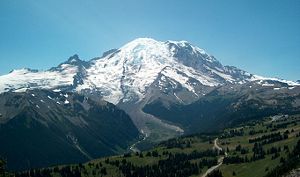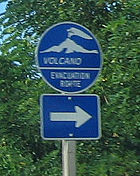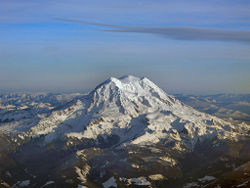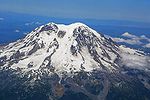Mount Rainier
| Mount Rainier | |||
|---|---|---|---|
 Mount Rainier as viewed from the Sourdough Ridge trail. | |||
| Elevation | 14,410 ft (4,392 m) | ||
| Location | Washington State, USA | ||
| Mountain range | Cascades | ||
| Prominence | 13,211 ft (4,026 m) Ranked 21st | ||
| Geographic coordinates | {{#invoke:Coordinates|coord}}{{#coordinates:46|51|11.9|N|121|45|35.6|W|type:mountain_region:US | name=
}} | |
| Topographic map | USGS Mount Rainier West | ||
| Type | Stratovolcano | ||
| Geologic time scale | 500,000 years | ||
| Last eruption | 1854 | ||
| First ascent | 1870 by Hazard Stevens and P.B. Van Trump | ||
| Easiest Climbing route | rock/ice climb via Disappointment Cleaver | ||
Mount Rainier is a stratovolcano in Pierce County, Washington, located 54 miles (87 km) southeast of Seattle, Washington, in the United States. It is a member in the Cascade Volcanic Belt and is the highest peak in the Cascade Range, with a topographical summit of 14,411 feet (4,392 m). The mountain and the surrounding area comprise Mount Rainier National Park, and covers 377.78 square miles. The mountain at its base covers 100 square miles. With 26 major glaciers, Mount Rainier is the most heavily glaciated peak in the lower 48 states at 35 square miles of snow and glaciers. It also has the lowest glacier in the continental U.S at an elevation of just 1600 ft. Heat from the volcano keeps areas of the crater rim on its summit cone mostly free of snow and ice. The geothermal heat has also caused the formation of glacier caves in the twin summit craters.
Mount Rainier was originally known as Talol, Tahoma, or Tacoma, from the Puyallup word təqʷúʔbəʔ ("mother of waters"). It has a topographic prominence of 13,211 feet (4,026 m), greater than that of K2. It is a prominent feature of the southern landscape in most of the Seattle metropolitan area. On clear days, it can also be seen from as far away as Portland, Oregon, and Victoria, British Columbia.
The Carbon River, Puyallup River, Nisqually River, and Cowlitz Rivers begin at the glaciers of Mount Rainier. The sources of the White River in Washington state are Winthrop, Emmons, and Fryingpan Glaciers. The White and Carbon Rivers join the Puyallup River, which discharges into Commencement Bay at Tacoma, Washington. The Nisqually empties into Puget Sound east of Lacey, Washington; and the Cowlitz joins the Columbia River between Kelso, Washington and Longview, Washington.
Washington State is crammed with vertical topography, but when locals mention "The Mountain," there's no mistaking which peak they're referring to. At 14,411 feet, Mount Rainier is without peer in this part of the world. It towers 8,000 feet above surrounding Cascades peaks, and is such a behemoth that it creates its own weather. [2]
Geography
Mount Rainier is an active Cascade Range volcano encased in over 35 square miles of snow and glacial ice. The 14,410 foot mountain is surrounded by lush old growth forests, wildflower subalpine meadows and thundering waterfalls.
The broad top of Mount Rainier contains three named summits.
- Columbia Crest is the highest.
- Point Success is the second highest at 14,158 ft (4,315 m), at the southern edge of the summit plateau, atop the ridge known as Success Cleaver. It has a topographic prominence of about 138 ft (42 m), and as such is not considered a separate mountain.
- Liberty Cap is the lowest of the three summits at 14,112 ft (4,301 m). At the northwestern edge it overlooks Liberty Ridge, the Sunset Amphitheater, and the dramatic Willis Wall. Liberty Cap has a prominence of 492 ft (197 m), and so would qualify as a separate mountain under most strictly prominence-based rules. However it is not usually considered a separate mountain, due to the massive size of Mount Rainier, relative to which a 492 foot drop is not very large. [1]
High on the eastern flank of Mount Rainier is a peak known as Little Tahoma, a volcanic remnant of an earlier configuration of Mount Rainier. At 11,138 ft (3,395 m), it has a prominence of 858 ft (262 m), and is almost never climbed in direct conjunction with Columbia Crest, so it is usually considered a separate mountain.
Vegetation
In general a difference of 1000 feet in altitude brings about changes in plant and animal life that are quite similar to the changes caused by a difference of 300 miles in latitude. There are four life zones found on Mount Rainier; the Humid Transition, the Canadian, the Hudsonian and the Arctic-alpine. [2]
- The Humid Transition Zone takes in the area of elevation up to approximately 3,000 feet. It is the most heavily forested zone. Plants and animals in this zone blend into the Canadian zone so there is not a clear deliniation between species living in the two zones. The grand fir, western red cedar western hemlock, Pacific tree dogwood, and the Douglas fir are trees commonly found in this zone.
- The Canadian Zone covers the area from about 3,000 ft to up to 5,000 ft. In this zone, the trees are notably smaller and not as dense as in the Humid Transition Zone. The western hemlock and Douglas fir are its common members. Some other typical tree species found in the Canadian Zone are the amabilis fir, Alaskan cedar, noble fir, and western white pine.
- The Hudsonian Zone consists of sub-alpine meadows with alpine fir and Mountain Hemlock. It's range is from 5,000 to 6500 ft. There is snow in the area most of the year from about November 1 through July 4 with some snow still remaining until mid-summer.
- The Arctic-alpine Zone includes all of the area above the upper limit of tree growth. This zone is from about 6500 feet to the summit. Plants in this zone are found between 6500 and 7500 ft. There is about 80 square miles of this zone on Mt. Rainier. Some of the common plants are the mountain buckwheat, pussy paws, moss campion, and willow grass. Some mossses grow around the rim of the crater because of warm gases escaping from fissures near the summit. The Artic zone with its shallow soil and is many rocks is home to numerous species of insects and spiders. At Yakima Park near Frozen Lake and on Burroughs Trail one can find an exceptional Arctic-alpine growth, consisting of colorful Indian pink and Lyalls lupine growing out of the pumice type soil. [3]
Climate
A Pacific maritime climate characterized by rainy, mild winters and cool, dry summers controls northwest weather patterns. Mountain weather is very changeable. Wet, cold weather can occur anytime of the year. While late-July and August can be the driest, warmest time of the year, summer can also be wet and cool. [4]
Even though the northern section of the state of Maine and Mt. Rainier are on the same latitudinal lines, Mt. Rainier does not have the same frigid temperatures as Maine. The prevailing westerly winds, blowing in from the Pacific Ocean, bring more moderate temperatures to the mountain.
Longmire, located in the Humid Transition Zone, has an average temperature of 55 degrees F and a high of 105 Degrees F with a low of -9 degrees F. Paradise Park, in the Hudsonian Zone, has an average temperature of 47 degrees F. Its high is 92 degrees, with its lowest temperature being -20 F.
Common with other areas of like altitude west of the Cascade Range, it is characterized by heavy precipitation. Over 75% of the total annual precipitation falls from October through May. Based upon records of the U. S. Weather Bureau the average annual precipitation for Paradise Park (at 5,557 feet) is roughly 100 inches. This may be contrasted with the record for Longmire (at 2760 feet) where the average annual rate is about 78 inches.
Geological history
Mount Rainier's earliest lavas are over 840,000 years old and are part of the Lily Formation (2.9 million to 840,000 years ago). The early lavas formed a "proto-Rainier", or ancestral cone, prior to the present-day cone which is over 500,000 years old. The volcano is highly eroded, with glaciers on its slopes, and appears to be made mostly of andesite.
Around 5,000 years ago, a large chunk of the volcano slid away, with the resulting debris avalanche producing the massive Osceola Mudflow. This massive avalanche of rock and ice took out the top 1,600 ft. (488 m) of Rainier, bringing its height down to around 14,400 ft. (4,389 m). Prior to this, it is believed to have stood at 16,000 feet. [5] About 530 to 550 years ago, the Electron Mudflow occurred, although this was not as large-scale as the Osceola Mudflow.
After the major collapse 5,000 years ago, subsequent eruptions of lava and tephra (air-fall material) built up the modern summit cone until as recently as 1,000 years ago. As many as 11 Holocene epoch tephra layers have been found.
The most recent recorded volcanic eruption was between 1820 and 1854, though many eyewitnesses had reported eruptive activity in 1858, 1870, 1879, 1882 and 1894 as well. Though there seems to be no imminent risk of eruption, geologists expect that the volcano will erupt again.
Lahars
In the past, Mount Rainier has had not only large debris avalanches, but has also produced enormous lahars (volcanic mudflows) due to the large amount of glacial ice present. Its lahars have reached to Puget Sound, 150 miles away.
One of the greatest volcanic hazards is lahars, which are similar to pyroclastic flows but contain more water. Lahars formation comes from several sources:
- from debris avalanches that contain water from snow and ice which, when released, mixes with loose debris to form a lahar,
- from pyroclastic flows and surges which release water that mixes with debris,
- from pyroclastic flows which dilute themselves with river water as they travel downslope,
- from natural dam failure (such as a lava flow dam or crater lake), and
- from rainfall on loose material such as ash. Lahars that contain 20 to 60 percent sediment are usually very turbulent. [6]
A lahars flow is similar to that of wet concrete. Once they are flowing, they can reach speeds of 70 - 80 kilometers per hour and have depths up to 30 meters. Large lahars have occured on Mt. Rainier every 500 to 1000 years. The most recent large lahar poured into the Puyallup River Valley about 575 years ago. Geologists have every reason to expect that future lahars will continue their reoccuring pattern.
According to geologists, due to the weakening of Rainier by hydrothermal activity combined with its heavily–iced top, the threat of lahars is real. Such a mudflow could destroy much of the heavily populated western Washington state. Reaching to Puget Sound, it could cause tsunamis there as well as in Lake Washington.
Monitoring systems
With Mount Rainier considered an active volcano, and the heavy population numbers surrounding it, there is vigilant monitoring performed by the United States Geological Survey (USGS)at the Cascade Volcano Observatory in nearby Vancouver, Washington. The University of Washington (Seattle) also measures, on a regular basis, any changes in shape of the mountain.
Mount Rainier is carefully monitored for signs of volcanic reawakening, and an eruption that could produce a catastrophic lahar initiated by vigorous release of meltwater is expected to follow days, weeks, or even months of readily detected symptoms of volcanic unrest. Thus, it is likely that there will be opportunity for citizens and communities to prepare for an impending eruption. Inasmuch as lahars seek valley bottoms, people can quickly climb or drive to safety in many cases by simply evacuating the floor of a well-defined valley before the lahar arrives; they need go no farther than high ground adjacent to the valley. A critical issue is to know when evacuation is necessary. Travel time for a large lahar from Mount Rainier may be an hour or less to Orting, the city closest to Mount Rainier in the Puyallup valley, and possibly as little as 30 minutes may be available from detection of a large lahar to its arrival. Successful evacuation there will depend on detection of an approaching lahar, clear warning, public understanding of the hazard, and practiced response by citizens. Decreased lahar velocity as the valleys broaden downstream gives more time—about an additional hour—for response in the larger urban areas of Puyallup and Sumner, which are closer to Puget Sound.
It is critical that the lahar-detection system be completely automatic. Except during volcanic unrest when intense around-the-clock monitoring by a team of volcanologists is underway, the time from initiation of a lahar to its arrival in a populated valley-floor area is insufficient for analysis of the data by scientists before notices are issued. Thus the system must be designed to unfailingly detect a lahar with minimum opportunity for false alarms. [7]
Human history
Mount Rainier was first known by the Native Americans as Talol, Tahoma, or Tacoma, from the Puyallup word təqʷúʔbəʔ ("mother of waters"). At the time of European contact, the river valleys and other areas near the mountain were inhabited by many Pacific Northwest tribes who hunted and gathered berries in the forests and mountain meadows. These tribes included the Nisqually, Cowlitz, Yakama, Puyallup and Muckleshoot.
Captain George Vancouver reached Puget Sound in 1792 and became the first European to see the mountain. He named it in honour of his friend, Rear Admiral Peter Rainier.
In 1833, Dr. William Fraser Tolmie explored the area looking for medicinal plants. He was followed by other explorers seeking challenge. Hazard Stevens, Philemon Van Trump hired a Yakima Indian named Sluiskin to be their guide to reach the summit of Mt. Rainier. They reached their goal on Aug 17, 1870, after 10 and one half hours of climbing, and left a brass nameplate and a canteen on the summit to document the first successful ascent recorded. Stevens and Van Trump received a hero's welcome in the streets of Olympia, Washington after their successful summit climb. More people came to climb the mountain. In 1890, Fay Fuller became the first woman to climb Mount Rainier.[8] John Muir climbed Mount Rainier in 1888, and although he enjoyed the view, he conceded that it was best appreciated from below. Muir was one of many who advocated protecting the mountain. In 1893, the area was set aside as part of the Pacific Forest Reserve in order to protect its physical/economic resources: timber and watersheds.
Citing the need to also protect scenery and provide for public enjoyment, railroads and local businesses urged the creation of a national park in hopes of increased tourism. On March 2, 1899, President William McKinley established Mount Rainier National Park as America's fifth national park. Congress dedicated the new park "for the benefit and enjoyment of the people; and...for the preservation from injury or spoliation of all timber, mineral deposits, natural curiosities, or wonders within said park, and their retention in their natural condition."
In 1998, the United States Geological Survey began putting together the Mount Rainier Volcano Lahar Warning System to assist in the emergency evacuation of the Puyallup River valley in the event of a catastrophic debris flow. It is now run by the Pierce County, Washington Department of Emergency Management. Tacoma, at the mouth of the Puyallup, is only 37 miles (60 km) west of Rainier, and moderately sized towns such as Puyallup, and Orting, Washington are only 27 and 20 miles (44 and 32 km) away, respectively.
Recreation
Mountain climbing on Rainier is made difficult, because it includes climbing on the largest glaciers in the U.S., south of Alaska. The mountain is very steep and rugged . Most climbers require two to three days to reach the summit. Climbing teams require experience in glacier travel, self-rescue, and wilderness travel. There are approx. 8,000 to 13,000 people who attempt the climb each year, [9]. About 90% of the climbs are via routes from Camp Muir on the southwest flank. Most of the ascends of Emmons Glacier, the largest glacier on the mountain, are via Camp Schurman on the northeast. Only about half of the attempts are successful, with weather and conditioning being the most common reasons for failure. Each year there are about three mountaineering deaths on the mountain. These occur due to rock and ice fall, avalanche, falls, and hypothermia associated with severe weather. The weather is very volatile on the mountain and can be wet and cold anytime of the year. [10]
The many types of animals such as chipmonks, chickarees, ground squirrels, marmots, pika, deer, elk and mountain goats that are included in the more than 54 types of mammals on the mountain contribute to the popularity of hiking, camping and photography.Bird watchers can find birds such as Clark's nutcrackers, gray jays, Steller's jays, ravens and hundreds of birds including the Northern Spotted Owl. [11] Over 3 million people per year travel to the flanks of the mountain, in its parks and woodlands.
For nearly 100 years people have hiked and camped in the backcountry of Mount Rainier National Park. Even before the dedication of the park in 1899, hiking enthusiasts and park employees have built, maintained, and utilized hundreds of miles of trails around the mountain. There are several hiking trails, including the Wonderland Trail, a 93-mile circumnavigation of the peak. Mount Rainier is also popular for winter sports, including snowshoeing and cross-country skiing because of the amount of snowfall; for example, Mt. Rainier had a record high of snowfall in 1972 with 94 feet at Paradise Park. [12]
In 1988, 228,480 acres, 97% of Mount Rainier National Park, were designated Wilderness by Public Law 100-668 (The Washington Wilderness Act). The ensuring Wilderness Management Plan divided the park's wilderness into three zones: Trailside, Crosscountry, and Alpine. Along with other limitations, maximum capacities have been placed on the number of people in any one area, and time retrictions in certain areas apply also.
Foot Notes
- ↑ Klist, Peter. Master List of Peaks in Washington, The Northwest Peakbagger's Asylum. Retrieved April 3, 2007.
- ↑ Flora of Mt. Rainier National Park, NATIONAL PARK SERVICE. Retrieved April 3, 2007.
- ↑ Mt. Rainier Birds, National Park Service. Retrieved April 3, 2007.
- ↑ Mount Rainier, National Park Service. Retrieved April 3, 2007.
- ↑ Pilot Project Mount Rainier Volcano Lahar Warning System, U.S. Geological Survey, Retrieved March 31, 2007.
- ↑ Riley, C.M. Lahars, Michigan Technological University. Retrieved April 3, 2007.
- ↑ Pilot Project Mount Rainier Volcano Lahar Warning System, U.S. Geological Survey. Retrieved April 3, 2007.
- ↑ http://www.mount.rainier.national-park.com/info.htm
- ↑ [1]
- ↑ http://www.google.com/search?hl=en&rlz=1T4GGIC_enUS212US212&sa=X&oi=spell&resnum=0&ct=result&cd=1&q=Mt+Rainier+coldest+temperature+at+the+summit&spell=1
- ↑ cliffs.http://www.mount.rainier.national-park.com/info.htm
- ↑ http://gorp.away.com/gorp/resource/us_national_park/wa_mount.htm
Sources and Further Reading
- Harris, Stephen L, Fire mountains of the West : the Cascade and Mono Lake volcanoes, Montana, Mountain Press Pub. Co., 2005, ISBN 087842511X
- Sisson, Thomas W, History and Hazards of Mount Rainier, Washington, Washington, Cascades Volcano Obervatory, 1995, OCLC 48548643
- Riley, C.M. Lahars, Michigan Technological University. Retrieved April 3, 2007.

External links
- Mount Rainer, TierraWiki, Accessed March 19, 2007
- Pilot Project Mount Rainier Volcano Lahar Warning System, United States Gelogical Survey, Accessed March 19, 2007
- Mount Rainier, Washington Major Drainages, United States Gelogical Survey, Accessed March 19, 2007
- Mount Rainier, Washington, Peak Bagger, Accessed March 19, 2007
- Mount Rainier, Bivouac, Accessed March 19, 2007
- Mount Rainier, Summit Post, Accessed March 19, 2007
- Mount Rainier National Park, Terra Galleria, Accessed March 19, 2007
- Mt Rainier, Destination 360, Accessed March 19 ,2007
- Mt. Rainier Photographs, Digital Collections, Accessed March 19, 2007
- The Mountaineers Collection, Digital Collections, Accessed March 19, 2007
- Henry M. Sarvant Photographs, Digital Collections, Accessed March 19, 2007
- Alvin H. Waite Photographs, Digital Collections, Accessed March 19, 2007
- Parchman, Frank, Oct 19-25, 2005, The Super Flood, Seattle Weekly, Accessed March 19, 2007
- Maps and aerial photos
- WikiSatellite view at WikiMapia
- Topographic map from TopoZone
- Surrounding area map from Google Maps
- Location in the United States from the Census Bureau
| Major Cascade Volcanoes | 
|
|---|---|
| Mount Silverthrone | Mount Meager | Mount Cayley | Mount Garibaldi | Mount Baker | Glacier Peak | Mount Rainier | Mount St. Helens | Mount Adams | Mount Hood | Mount Jefferson | Three Sisters | Newberry Volcano | Mount Mazama | Mount McLoughlin | Medicine Lake Volcano | Mount Shasta | Lassen Peak |
| U.S. State Highest Points | 
|
|---|---|
| Alabama - Alaska - Arizona - Arkansas - California - Colorado - Connecticut - Delaware - Florida - Georgia - Hawaii - Idaho - Illinois - Indiana - Iowa - Kansas - Kentucky - Louisiana - Maine - Maryland - Massachusetts - Michigan - Minnesota - Mississippi - Missouri - Montana - Nebraska - Nevada - New Hampshire - New Jersey - New Mexico - New York - North Carolina - North Dakota - Ohio - Oklahoma - Oregon - Pennsylvania - Rhode Island - South Carolina - South Dakota - Tennessee - Texas - Utah - Vermont - Virginia - Washington - West Virginia - Wisconsin - Wyoming |
Credits
New World Encyclopedia writers and editors rewrote and completed the Wikipedia article in accordance with New World Encyclopedia standards. This article abides by terms of the Creative Commons CC-by-sa 3.0 License (CC-by-sa), which may be used and disseminated with proper attribution. Credit is due under the terms of this license that can reference both the New World Encyclopedia contributors and the selfless volunteer contributors of the Wikimedia Foundation. To cite this article click here for a list of acceptable citing formats.The history of earlier contributions by wikipedians is accessible to researchers here:
The history of this article since it was imported to New World Encyclopedia:
Note: Some restrictions may apply to use of individual images which are separately licensed.





